 |
||
|
||
| ||
Professional Sound Card of an Unusual Design, with Professional and Consumer JacksESI presented its new sound card called Juli@ at the world-famous exhibition Musikmesse (March 31 – April 3, 2004) in Frankfurt, Germany. The card is shipped in a nice box made as a book with a transparent inner side.  The box for ESI Juli@ is nice and functional BundleThe bundle of our sample card contained the following items:
Card-transformerThe unique feature of this card is the opportunity to transform it to user's needs: you can choose which jacks to use – professional 1/4" balanced jacks (1/4" TRS) or consumer RCA jacks.  ESI Juli@ sound card: Professional 1/4" balanced TRS jacks are active 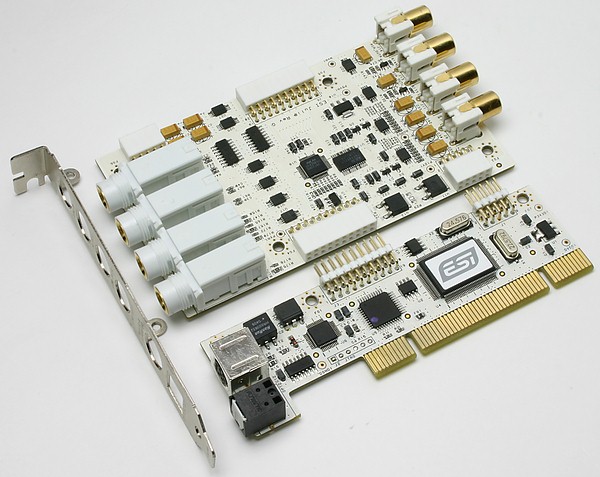 Disassembled ESI Juli@ sound card: The upper part turns 180 degrees 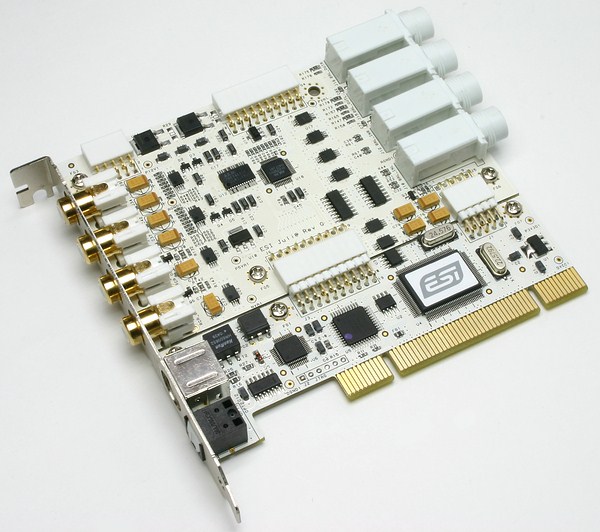 ESI Juli@ sound card: consumer RCA jacks are active InnardsThe main DSP chip labeled with the ESI logo is VIA Envy24HT-S (24-bit, 192 kHz; interfaces: three output I2S/AC-links, two input I2S/AC-links). Digital transceiver – AKM AK4114 (8 inputs, 2 outputs). 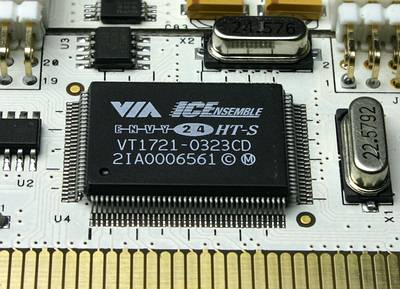 The main DSP chip: 24-bit, 192 kHz VIA Envy24HT-S The card uses an 8-channel multibit 24-bit 192 kHz DAC AKM AK4358 with reduced sensitivity to jitter, positioned by AKM for professional equipment as well as for consumer DVD-Audio and SACD (by the way, I wrote about the release of this DAC in our news a year ago). Dynamic range: 112 dB. THD+noise: -94 dB. 8 times 24-bit digital filter with an slow roll-off option (in this case this option is disabled to provide ideally even frequency response). DAC is not a top class, but quite good enough for a sound card in this price range. You can see on the ESI Juli@ block diagram that the 8-channel AKM 4358 DAC (marked as 4õ DAC) is used in this sound card on purpose — it monitors digital I/O with an absolute zero delay. ADC – dual bit delta-sigma stereo 24-bit 192 kHz AKM AK5385A has a little better characteristics; it is positioned by AKM for professional equipment to record audio in high definition formats, including DVD-Audio. Dynamic range: 114 dB. Signal/(noise+distortions): 103 dB. High-quality digital antialiasing filter with a linear phase, passband (Fs=48 kHz): 0~21.768 kHz, ripple: 0.005 dB, stopband: 100 dB. 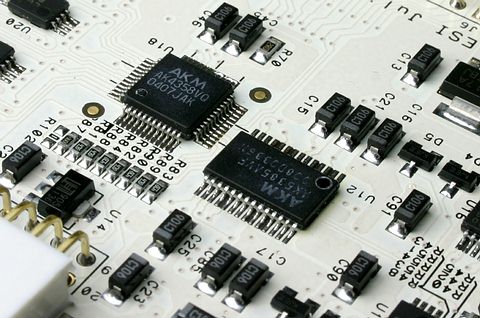 ESI Juli@ converters: AKM 4358 DAC and AKM 5385A ADC Some comments. Though DAC and ADC are of the same class in this sound card, ADCs are still a tad better than DACs. Perhaps, as it was with Waveterminal 192X, the engineers considered the digitization quality (ADC) to be more important in home/project studio than the slightly reduced quality of signal monitoring, other things being equal. But hi-end audio PC users (RCA jacks are a curtsy to them), who use their computers solely for high quality playback and who do not care about ADC, have a reason to pause – is the DAC comparable with the level of the rest of the sound playback section? If the rest of the sound section is much more expensive than the card (approximately over $600), so that the bottleneck is in the DAC quality as well, then they should pay attention to the mastering level sound cards. In general, it should be noted that in the price range up to $200 Juli@ demonstrates better DAC/ADC quality in comparison with similar old cards based on ENVY24 – various M-Audio Audiophile 2496, Echo MIA, etc. According to our measurements (using the same reference sound card) Juli@ is even better than the more expensive ESI Waveterminal 192Õ, which has better (according to the specification) ADCs. So in our opinion only EMU 1212M (with converters of a higher level) can be a serious competitor to the undoubtedly successful in price/quality Juli@. Despite this fact, many users of middle end sound sections will quite possibly prefer Juli@, because this ESI card is easier to control, it does not have problems with the MME/WDM interface support in high formats, it has a smoother frequency response of line outs, and it offers several useful proprietary features, which will be described later. Besides, EMU is very difficult to find on our shelves and this situation has not changed for half a year already.  ESI Juli@ control panel is easy and clear E-WDM technologyE-WDM technology (Enhanced Audio MIDI Driver) is a proprietary project of ESI, which enhances the original architectural concept of Microsoft WDM-drivers. Aside from standard features, E-WDM offers functions required for professional sound processing:
DirectWIRE: audio stream visual routing technologyDirectWIRE is a technology for visual software routing of signals, which is currently available in most ESI products. Signals are routed on the level of drivers, bit-to-bit, without quality loss. DirectWIRE 1.0 technology appeared in ESI Waveterminal 2496/192 when the Gigastudio sampler was still widely popular and initially it served to convert MIDI-tracks to WAV from Gigastudio (GSIF interface) into Cubase (ASIO) or into Cakewalk/SONAR1 (MME). 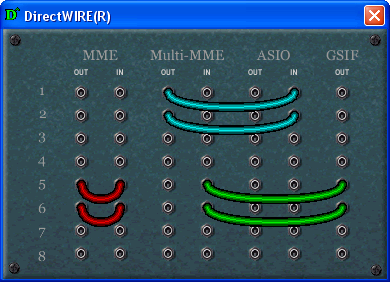 DirectWIRE 1.0 panel in ESI Waveterminal 192X DirectWIRE 2.0 supports 32 channels, it has a new control panel, and an option to mute monitoring of selected output channels. You can switch inputs and outputs of the MME, WDM, ASIO, GSI/F program interfaces, even if they work simultaneously. You can connect inputs and outputs of different applications with virtual cables and record signals without quality loss. Using DirectWIRE you can also record multi-channel audio from DVD or another source (even protected from copying) in formats up to 24-bit 192 kHz in real time in completely digital form.  DirectWIRE 3.0 panel in ESI Juli@ DirectWIRE 3.0 was enhanced with hardware inputs. In Juli@ Virtual Inputs 1 and 2 are the left and the right hardware analog inputs, 3 and 4 – the left and right hardware digital S/PDIF input. Interface names mean the following applications:
You can read this Audiotrak tutorial to learn how to use DirectWIRE 3.0 with detailed examples. Digital and MIDI InterfacesJuli@ stands out against other ESI products with its MIDI I/O, digital RCA I/O, and a digital optical output. You had to buy a separate MI/ODI/O module to get these features in Audiotrak MAYA44MKII and ESI Waveterminal 192X/L. Though there are also modifications with MI/ODI/O module in a box now, it occupies an additional bracket among PCI slots. Sound QualityJuli@ vs. Audigy2 ZS Platinum Pro These two cards can be compared due to similar prices ($185 for the ESI product and $240 for the Creative product) and professional attributes (external block with a full set of connectors) in Audigy, which is essentially a gaming card. Functionality of Juli@ and Platinum Pro in terms of a microphone preamplifier and phone-in can be leveled up by adding an inexpensive external analog mixer (about $50) to Juli@, but it's quite possible that an external mixer is already available in home/project studio. Before the comparative audition I had no subjective preferences – the cards have converters of the same class, and thus I didn't expect considerable differences in sound quality. Nevertheless, the difference between the cards can be clearly heard even using the active speakers JetBalance JB-381 (by the way, very good speakers at a moderate price at last, less than $200). In the 16 bit 44 kHz mode A2 is traditionally weak at playing via the MME interface, and it's much better at playing via the professional packaged "SB Audigy2 ZS ASIO" driver with enabled SSRC high quality resampling to 48 kHz. But Juli@ produces crisper and more detailed sounds, and thus it's more suitable for a professional. Though this can be heard only when you instantly switch between the cards playing the same music fragment. If you increase the time between the auditions to a couple of minutes, you won't be able to distinguish the cards even with the same music fragment. One way or another, I clearly hear the difference, for example at Alex Reece, 1996 album "So Far" (hits: Feel The Sunshine, Pulp Friction) and some other test compositions with clear compressed mastering and timbre-catchy high frequency range. Juli@ vs. EMU 1820 Despite the high price ($400) and the increased number of channels in EMU1820, Juli@ can compete with it head-to-head, because the Creative/EMU product has converters of the same level (CS4392). Both cards, Juli@ and 1280, were tested in balanced mode, high signal level (+4 dBu) to increase the dynamic range and to demonstrate sound cards' features at maximum. The auditions were also carried out on EVENT 20/20 bas monitors, allowing the balanced connection. Thorough audition in the same conditions, using the same cable and instantly switching between the cards did not reveal any difference in their sounding. However, considering the high price of EMU1820, it cannot be called a successful sound card – it's an economic modification of the elder 1820M. 1820 is of lower quality than even the younger 1212M model. Forestalling your questions: we don't have an opportunity to compare it with EMU 1212M or 1820M, because these cards cannot be found on sale in Russia. US EMU office promised to send us a press-sample, but we lost contact with it. If we still have an opportunity, we'll update this article. Juli@ vs. LynxTwo Comparison with LynxTwo (price >$1000, stereo-modification is Lynx L22, >$800) in our tests is traditional, it serves to reveal the degree and character of sound differences between a sound card under review and a reference sound source. We hasten to say, LynxTwo sounds better. The difference is not so large but it still makes itself felt. Nevertheless, Juli@ demonstrates professional sound quality in comparison with the reference. Multimedia cards (for example, Audigy2/ZS) are usually infamous for timbre distortions, various tones and harmonics at high frequencies. So despite their rather high quality converters, such cards cannot be used for professional work. Juli@ is free from these drawbacks, it sounds true and clear. The only difference from Lynx is in a tad lesser detail, which will hardly influence its professional capability, except for the mastering. HeadphonesDespite the fact that this card does not have a separate output to headphones, they can be connected using the 2RCA-minijack adapter. Using Sennheiser HD600 (400 ohm impedance) via the adapter caused no problems with sound. Besides, we carried out the following interesting experiment: we connected a variable resistor to the output, and applied a maximum amplitude sinusoid to the output of the card. On the digital oscillograph EZ Digital OS-310M we monitored how the amplitude changed and at what resistance there would be a limitation. In comparison with the pure linear output in MAYA44MKII with the limitation at ~100 ohm and lower, Juli@ was OK. Operational amplifiers JRC 4580 hold well the low impedance load, though the Juli@ specification requires the load impedance of not less than 100 ohm. By the way, MAYA44MKII has an output for headphones, which is also OK. Working in Professional ApplicationsNo surprises here. As any sound card based on the ENVY24 series chip, Juli@ demonstrated excellent results in ASIO-applications CubaseSX 2.0.1 and WaveLab 5.0a. 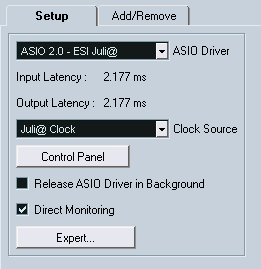
Besides, InterVideo WinDVD 6.0 works correctly with the card as well. When playing DVD-Audio discs, they are downsampled to 16/48. RMAA 5.4 TestsMany users ask us to test not only the quality of linear output, but that of the linear input as well. It is especially important for professional equipment, so we tested the card in three modes: when the output and the input of the card are connected, input and output are connected separately using LynxTwo – a reference card of a higher quality.
When the linear input is tested in the balanced mode using LynxTwo, the frequency response gets worse in this test as well as in all the other ones. In the loopback mode (when the output and the input of the card are connected) there is no such drawback, thus we have some disalignment in the operation of balance interfaces in this specific device combo. This is another reason not to use balance connection needlessly.
Note the ideally steady frequency response graph and the ideally clear noise spectrum in the 24-bit mode. The noise level measured is close to the claimed figures in the converter specifications. Engineers made the most of the existing converters. 
In the 96 kHz mode the spectrum is reproduced completely, as it should be. I'll remind you that EMU cards have problems with frequency response in DAC, which is -0.7 dB for 20 kHz. 
In digital output tests Juli@ is equal to LynxTwo.
In the 24/96 mode the ideal is even farther from our contenders. The reason is most likely not in the lack of bit-to-bit transfer precision, but in the PLL influence in the transceivers or in dithering reformation. One way or another, it's impossible to hear the difference between the original and the received sound – the differences are below the thermal noise threshold in semiconductors, and any digital-analog conversion will guarantee much more audible inaccuracies – the native level of noise in modern DAC is hardly over 120 dB A. RightMark 3DSound 1.20 TestsWe test DirectSound functions of the card, because we have such an opportunity. RM 3DS tests demonstrate DirectSound compatibility but also the lack of any algorithms of software 3D sound. Just for information. Device: Juli@ Ch12 (JulaWdm.sys) Features: Rates: Free buffers stats: Max buffers stats: Misc stats: Audio transfer speed (software): 3.289 Mb/sec. Exclusive iXBT.com interview
|
|
Article navigation: |
| blog comments powered by Disqus |
| Most Popular Reviews | More RSS |
 |
Comparing old, cheap solutions from AMD with new, budget offerings from Intel.
February 1, 2013 · Processor Roundups |
 |
Inno3D GeForce GTX 670 iChill, Inno3D GeForce GTX 660 Ti Graphics Cards A couple of mid-range adapters with original cooling systems.
January 30, 2013 · Video cards: NVIDIA GPUs |
 |
Creative Sound Blaster X-Fi Surround 5.1 An external X-Fi solution in tests.
September 9, 2008 · Sound Cards |
 |
The first worthwhile Piledriver CPU.
September 11, 2012 · Processors: AMD |
 |
Consumed Power, Energy Consumption: Ivy Bridge vs. Sandy Bridge Trying out the new method.
September 18, 2012 · Processors: Intel |
| Latest Reviews | More RSS |
 |
Retested all graphics cards with the new drivers.
Oct 18, 2013 · 3Digests
|
 |
Added new benchmarks: BioShock Infinite and Metro: Last Light.
Sep 06, 2013 · 3Digests
|
 |
Added the test results of NVIDIA GeForce GTX 760 and AMD Radeon HD 7730.
Aug 05, 2013 · 3Digests
|
 |
Gainward GeForce GTX 650 Ti BOOST 2GB Golden Sample Graphics Card An excellent hybrid of GeForce GTX 650 Ti and GeForce GTX 660.
Jun 24, 2013 · Video cards: NVIDIA GPUs
|
 |
Added the test results of NVIDIA GeForce GTX 770/780.
Jun 03, 2013 · 3Digests
|
| Latest News | More RSS |
Platform · Video · Multimedia · Mobile · Other || About us & Privacy policy · Twitter · Facebook
Copyright © Byrds Research & Publishing, Ltd., 1997–2011. All rights reserved.